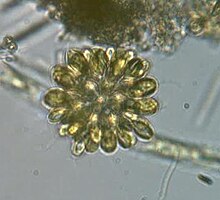Synura is a genus of colonial chrysomonad algae covered with silica scales.[3] It is the most conspicuous genus of the order Synurales.[4]
| Synura | |
|---|---|

| |
| A colony of Synura sp. | |
| Scientific classification | |
| Domain: | Eukaryota |
| Clade: | Diaphoretickes |
| Clade: | SAR |
| Clade: | Stramenopiles |
| Phylum: | Gyrista |
| Subphylum: | Ochrophytina |
| Class: | Chrysophyceae |
| Order: | Synurales |
| Family: | Synuraceae Lemmermann, 1899 emend. B.Y. Jo, J.I. Kim, W. Shin, P.Škaloud & P. Siver, 2016[1] |
| Genus: | Synura Ehrenberg, 1834 |
| Species | |
| Synonyms[2] | |
| |
Description
editSpecies of Synura form microscopic, spherical colonies, composed of multiple cells attached to each other at the center of the colony. Synura cells are variously shaped, typically spherical to pear-shaped or club-shaped. Each cell contains two plastids aligned with the long axis of the cell; they impart a distinctive golden color to the cells, which comes from chlorophyll c1 and fucoxanthin. Cells are covered with scales made of silica. Two flagella are present.[5]
Identification of species depends on the morphology of the scales. For many species, a positive identification is only possible with an electron microscope, either with scanning electron microscopy (SEM) or transmission electron microscopy (TEM).[5]
Classification
editSynura is the type and only genus in the family Synuraceae.[1] The present taxonomy recognizes five sections:[3][4]
- Section Peterseniae
- Section Spinosae
- Section Echinulatae
- Section Splendidae
- Section Uvellae
References
edit- ^ a b Bok Yeon Jo; Jong Im Kim; Pavel Škaloud; Peter A. Siver; Woongghi Shin (1 September 2016). "Multigene phylogeny of Synura (Synurophyceae) and descriptions of four new species based on morphological and DNA evidence". European Journal of Phycology. 51 (4): 413–430. doi:10.1080/09670262.2016.1201700. ISSN 0967-0262. Wikidata Q99647124.
- ^ Pusztai, Martin; Čertnerová, Dora; Škaloudová, Magda; Škaloud, Pavel (2016). "Elucidating the Phylogeny and Taxonomic Position of the genus Chrysodidymus Prowse (Chrysophyceae, Synurales)". Cryptogamie, Algologie. 37 (4): 297–307. doi:10.7872/crya/v37.iss4.2016.297. S2CID 51739744.
- ^ a b Škaloud, Pavel; Kristiansen, Jørgen; Škaloudová, Magda (July 2013). "Developments in the taxonomy of silica-scaled chrysophytes – from morphological and ultrastructural to molecular approaches". Nordic Journal of Botany. 31 (4) (published August 2013): 385–402. doi:10.1111/j.1756-1051.2013.00119.x.
- ^ a b Škaloud P, Škaloudová M, Procházková A, Němcová Y (2014). "Morphological delineation and distribution patterns of four newly described species within the Synura petersenii species complex (Chrysophyceae, Stramenopiles)". European Journal of Phycology. 49 (2): 213–229. Bibcode:2014EJPhy..49..213S. doi:10.1080/09670262.2014.905710. S2CID 51749551.
- ^ a b Siver, Peter A. (2014). "Chapter 14. Synurophyte Algae". In Wehr, John D.; Sheath, Robert G.; Kociolek, J. Patrick (eds.). Freshwater Algae of North America: Ecology and Classification (2 ed.). Elsevier Inc. ISBN 978-0-12-385876-4.